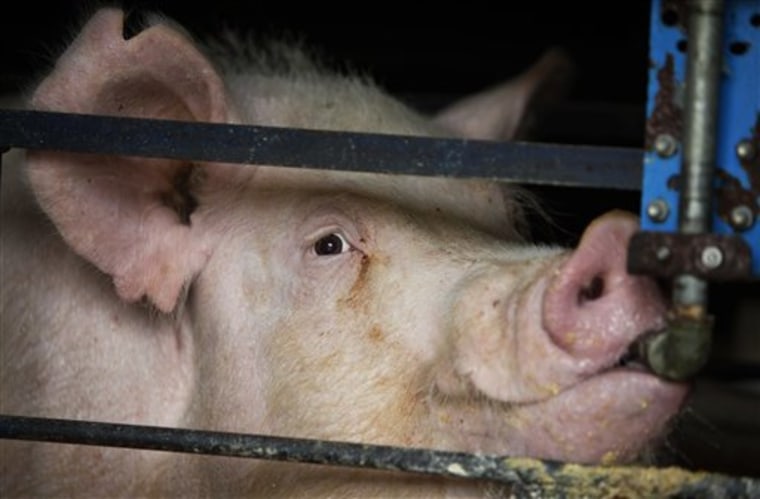Marty Malecek got a business degree intending to take over the Minnesota hog farm that his father started nearly 20 years ago. Instead, they are selling their 1,700 hogs and auctioning off land after it became clear that they could no longer cover their costs.
It was a combination of blows: rising feed costs as the production of ethanol increased competition for corn and soybeans. High energy costs. A drop in demand as the recession meant people were eating less meat. The resulting oversupply that kept prices low. And then, swine flu.
"We wanted to be a family farm and keep on producing hogs," said Malecek, 33. "We were holding out hope until two or three weeks ago."
The pain has been felt across the industry. While larger, more-diversified operations will likely survive, industry officials, producers and analysts say many small- and medium-sized farmers could be forced out of business. Most are family-run operations, meaning relatives could all be out of work. And it could mean roller-coaster prices at the store until supply and demand come back in line.
"It was really tough on my parents, especially my dad," Malecek said of his 72-year-old father, who began running the operation on their farm north of Redwood Falls, Minn., in 1991.
Dave Struthers, a hog farmer near Collins, Iowa, has reduced his sow numbers 25 percent, from 1,000 early last year to 750, and laid off two employees — but he doesn't know if that will suffice.
"If we can't start making some money with what we've got, there comes a time where you say enough's enough and you don't know when that time will be," he said.
The industry produced a record number of hogs in 2008, with the U.S. Department of Agriculture showing 116.5 million hogs slaughtered. Now, since the swine flu outbreak, USDA forecasts call for U.S. pork exports to decline at least 12 percent in 2009. Through April, they're down about 11 percent, or about 167 million pounds, according to the USDA.
"It's almost laughable because it's so horrible," said Iowa hog producer Chuck Wirtz, who is an owner or shareholder in sow operations in Iowa, Illinois and Wisconsin. He presented a proposal at the World Pork Expo earlier this month that he hoped would stabilize the market by offering farmers incentives to retire and reducing the number of hogs.
But he said the idea — a self-funded program by U.S. producers that would have needed to raise $60 million — is likely no use now.
Shane Ellis, a livestock economist at Iowa State University in Ames, said it could also be too late for many small operators to make the kind of production cuts they need to.
"Producers that aren't efficient will be hit first," Ellis said. "Those are the operators that we will see exit the market. Not the big operators."
The industry has lost an estimated $4 billion over the past 20 months, said Dave Warner, spokesman for the Washington-based National Pork Producers Council. Although a drop in exports has worsened matters, feed costs may be the biggest problem. "It doesn't take a rocket scientist to figure out the issue is grain costs," said Larry Pope, CEO of Smithfield Foods Inc., the nation's largest hog producer and pork processor.
Producers were losing up to $45 a head in mid-2008, Warner said. That dropped to about $11 a head when the swine flu outbreak hit in late April, and have since climbed to $20 a head. Those kind of numbers mean smaller farmers could face pressure to shut down.
"Maybe not the really big guys, but some medium-sized operations will get out too, but it's harder for the smaller guys to handle the sustained losses," he said.
Struthers said the problem may have been avoided if producers had cut their herds by the 10 percent analysts recommended. But some put it off because the futures market began to brighten in February and March, he said, and they believed they could see some profits this summer.
"And then H1N1 came out, and people were calling it swine flu," Struthers said.
A 4 percent reduction in production so far this year has been dwarfed by a 25 percent decline in prices, said Akshay Jagdale, an analyst with KeyBanc Capital Markets. Smithfield has announced a 13 percent cut in its sow herd, he said, and other producers must cut theirs by at least 10 percent for the market to improve.
Smithfield, which posted a smaller-than-expected fourth-quarter loss, saw earnings in its packing operation help cushion losses in production.
"That diversification, the strength on their balance sheet and the support from lenders, that's the main differentiating factor relative to others," Jagdale said. "They have access to capital that others don't."
Gerald Warren, a North Carolina pork producer, also raises beef and grows corn, cotton, sweet potatoes and tobacco.
"If we were strictly in the hog business we'd be in trouble," Warren said.
